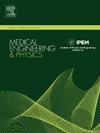Surrogate-based positioning optimization of hip prostheses for minimal stress shielding
IF 1.7
4区 医学
Q3 ENGINEERING, BIOMEDICAL
引用次数: 0
Abstract
The stress shielding phenomenon causes undesirable changes in stress distribution in the bones in which implants are implanted. This phenomenon leads to a gradual decrease in bone density in the vicinity of the implant and ultimately loosening. To improve the endurance of the prosthesis and postpone the revision surgery the prosthesis should be designed and positioned in such a way that the post-implant stress distribution within the bones is as close to the natural distribution as possible.
We formulate the problem of achieving a near-normal stress distribution as a constrained optimization problem in which the difference between pre- and post-implant stress distributions constitutes the loss function and five positional and dimensional parameters, including Femoral Anteversion, Neck Shaft Angle, Femoral Head Offset, Cup Version, and Cup Inclination comprise the set of design variables. Finite Elements (FE) analysis is used to obtain the stress distribution in bones before and after the implantation. To create a FE model, first a three-dimensional model of the patient's hip is created using CT images. The model is then subjected to the loads obtained from the patient's gait analysis, and the Stress Shielding Index (SSI) is calculated at critical points of the bones before and after the implantation. The difference between pre- and post-implant SSI values defines the cost function. To reduce the computational cost of numerous cost function evaluations a surrogate model (a 5 × 1 MLP neural network) is employed to predict the value of the cost function. Design Of Experiments (DOE) is used to sample the hyperspace of the design variables and generate training, test and validation data. The optimization problem is solved using Genetic Algorithms and the results are compared with the results of the best set of initial samples.
Results from the proposed approach show a significant reduction in the difference between pre- and post-implant stress distributions and a 12 % reduction in the Stress Shielding Index.
求助全文
约1分钟内获得全文
求助全文
来源期刊

Medical Engineering & Physics
工程技术-工程:生物医学
CiteScore
4.30
自引率
4.50%
发文量
172
审稿时长
3.0 months
期刊介绍:
Medical Engineering & Physics provides a forum for the publication of the latest developments in biomedical engineering, and reflects the essential multidisciplinary nature of the subject. The journal publishes in-depth critical reviews, scientific papers and technical notes. Our focus encompasses the application of the basic principles of physics and engineering to the development of medical devices and technology, with the ultimate aim of producing improvements in the quality of health care.Topics covered include biomechanics, biomaterials, mechanobiology, rehabilitation engineering, biomedical signal processing and medical device development. Medical Engineering & Physics aims to keep both engineers and clinicians abreast of the latest applications of technology to health care.
 求助内容:
求助内容: 应助结果提醒方式:
应助结果提醒方式:


